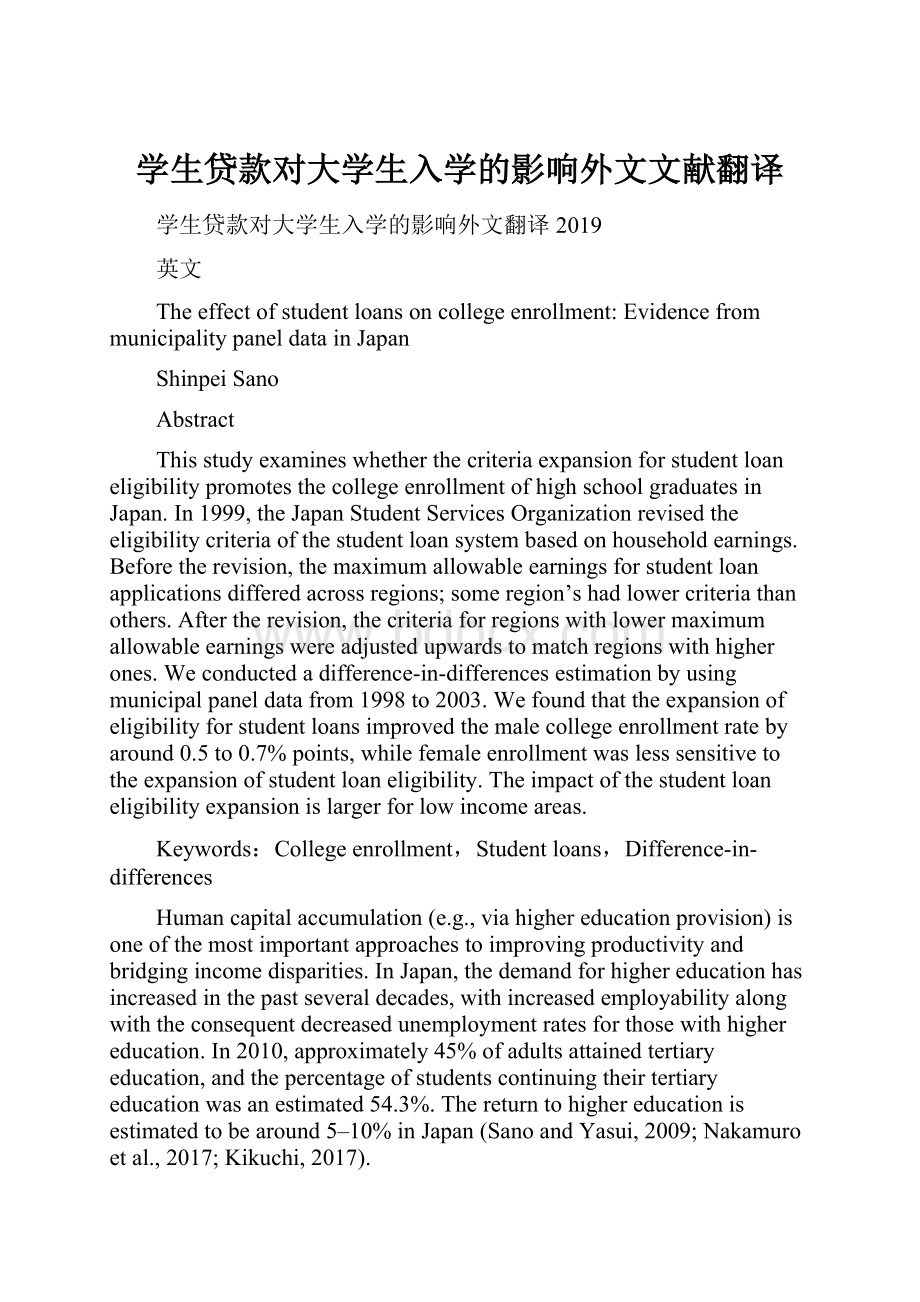学生贷款对大学生入学的影响外文文献翻译.docx
《学生贷款对大学生入学的影响外文文献翻译.docx》由会员分享,可在线阅读,更多相关《学生贷款对大学生入学的影响外文文献翻译.docx(11页珍藏版)》请在冰豆网上搜索。

学生贷款对大学生入学的影响外文文献翻译
学生贷款对大学生入学的影响外文翻译2019
英文
Theeffectofstudentloansoncollegeenrollment:
EvidencefrommunicipalitypaneldatainJapan
ShinpeiSano
Abstract
ThisstudyexamineswhetherthecriteriaexpansionforstudentloaneligibilitypromotesthecollegeenrollmentofhighschoolgraduatesinJapan.In1999,theJapanStudentServicesOrganizationrevisedtheeligibilitycriteriaofthestudentloansystembasedonhouseholdearnings.Beforetherevision,themaximumallowableearningsforstudentloanapplicationsdifferedacrossregions;someregion’shadlowercriteriathanothers.Aftertherevision,thecriteriaforregionswithlowermaximumallowableearningswereadjustedupwardstomatchregionswithhigherones.Weconductedadifference-in-differencesestimationbyusingmunicipalpaneldatafrom1998to2003.Wefoundthattheexpansionofeligibilityforstudentloansimprovedthemalecollegeenrollmentratebyaround0.5to0.7%points,whilefemaleenrollmentwaslesssensitivetotheexpansionofstudentloaneligibility.Theimpactofthestudentloaneligibilityexpansionislargerforlowincomeareas.
Keywords:
Collegeenrollment,Studentloans,Difference-in-differences
Humancapitalaccumulation(e.g.,viahighereducationprovision)isoneofthemostimportantapproachestoimprovingproductivityandbridgingincomedisparities.InJapan,thedemandforhighereducationhasincreasedinthepastseveraldecades,withincreasedemployabilityalongwiththeconsequentdecreasedunemploymentratesforthosewithhighereducation.In2010,approximately45%ofadultsattainedtertiaryeducation,andthepercentageofstudentscontinuingtheirtertiaryeducationwasanestimated54.3%.Thereturntohighereducationisestimatedtobearound5–10%inJapan(SanoandYasui,2009; Nakamuroetal.,2017; Kikuchi,2017).
InvestmentinhighereducationisheavilydependentonprivatesourcesinJapan.Forexample,ofthetotalamountspentontertiary-leveleducation,50.7%camefromhouseholdexpenditures(OECD,2012).Additionally,theOECDhighlightsthatalthoughtertiarytuitionfeesarehigh,andfinancialaidislimited,JapanremainsoneofthecountrieswiththelowestlevelsofpublicexpenditureontertiaryeducationagainsttheirGDP:
0.5%comparedtotheOECDaverageof1.1%.Policymakersandeducationresearchersadvocateforanincreaseofstudentaidoptionsforstudentsinhighereducation(Kobayashi,2009).
OneofthemajorstudentaidsourcesinJapanisthestudentloanssystemofferedbytheJapanStudentServicesOrganization(hereafterJASSO).Theproportionofuniversitystudentswhoareloanrecipientswas38.2%in2012.TheloanamountofferedbyJASSOwouldsufficientlycoveralmostallthetuitionfeesatnational/publicinstitutionsand80–99%ofthefeesatprivateuniversities.JASSO’sloanfacilitiesaimtoprovidefinancialassistancetoacademicallyexcellentstudentswhoareunabletopursuetheirstudiesduetofinancialreasons.
Understandingthemechanismsbywhichfinancialaidforhouseholdaffectseducationalinvestmentinhighereducationwouldhaveimportantpolicyimplications.Forexample,inthecaseofimperfectfinancialmarket,iflow-incomehouseholdswithfinancialconstrainsinvestlessintheirchildren’seducationthanwealthierhouseholds,offeringstudentloanbygovernmentcanbejustifiedonequitygrounds.Evaluatingtheimpactofstudentloanoninvestmentinhighereducationofferstheinformationaboutthedesignofstudentloansystemsuchastheloanamount,theeligibilitycriteriaforstudentloans.
Whilethestudyoftheimpactofstudentloansontertiaryenrollmentremainsimportantforresearchersandpolicymakers,therearetwochallengestoidentifytheimpactinJapan.Firstly,thechallengeinattemptingtoidentifythecausalimpactofstudentloanoncollegeenrollmentistheendogeneityofreceivingaloan.Sincestudentloansarereceivedbystudentswithbetteracademicbackgrounds,theirstudentloanvariablecouldreflectunobservedstudentcharacteristicsthataffectthedecisiontogotocollege.Inavastliterature,researchershavetriedtoeliminatetheunobservablefactorsusingexperimentaldesign.Forexample, Dynarski(2000, 2003), Cornwelletal.(2006), Singelletal.(2006), Winters(2012),andrelatedliteraturesutilizeexogenousvariationinbothbirthcohortandbirthplacetoevaluateStateMeritAidPrograminUS.1 Itisnoteasytofindthissituation,becauseJapanesestudentloansystemissettingunitary.
Secondly,thereisinsufficientresearchtoexaminetheeffectsofstudentaidinJapanduetothelackofaproperdatasetforanalysisofthedeterminantsofcollegeenrollment.PreviousresearchinJapanusedaggregateddata(Zani,1989)ormicrodatawithrestriction. Nakamura(1993) usedtheEmploymentStatusSurveyandfoundapositiverelationshipbetweenparentalbackgroundandcollegeenrollmentonlyforco-residenthighschoolstudentinmetropolitanareas. Kobayashi(2009)alsofoundapositiverelationshipbetweenparentalbackgroundandcollegeenrollmentforfreshmanusingtheStudentLifeSurvey.EmploymentStatusSurvey,largesamplecross-sectiondatawithrichinformationabouthousehold,canlinktheinformationbetweenhouseholdsituationandcollegeenrollmentonlyforco-residentcollegestudentsafterenrollmentdecisionduetosurveydesign.StudentLifeSurveyhasrichinformationaboutcollegestudents,butdoesnotincludeinformationatthetimingofenrollmentdecision.Neitherpreviousstudyanalyzedtheeffectofreceiptsofstudentloanspriortoentranceintocollegeondecisiontoenrollthecollegeduetodatalimitation.
Inthispaper,wefocusontheJASSOreformin1999toidentifytheeffectofstudentloansoncollegeenrollmentusingmunicipalitypaneldatatosolvetheseproblems.Oneofthemostfundamentalrevisionsofthisreformwasthechangeintheeligibilitycriteriaforstudentloansbasedonhouseholdearningsdependingontherecipient’smunicipalityofresidence.Beforetherevision,themaximumallowableearningsforstudentloanapplicationsdifferedacrossregions;thecriteriaforsomeregionswerelowerthanothers.Aftertherevision,thecriteriaintheregionswithlowermaximumallowableearningswereadjustedupwardstomatchregionswithhigherones.Inotherwords,thismeantthataftertherevision,morehighschoolstudentslivinginregionswiththelowercriteriawereeligibleforJASSOcollegeloans.Thissituationprovideduswithrelevantandappropriatecontextforanaturalexperimenttoidentifytheeffectofeligibilityexpansionforstudentloanswhilecontrollingforunobservedfactorsthatmayaffectthedecisiontoenrollintertiaryeducation.Additionally,weusethemunicipalitypaneldatabasedon theBasicSchoolSurvey.Thissurvey,school-relatedstatistics,includesnumberofcollegeanduniversitystudentsenrolledfromsurveyedschool,butdoesnotincludethehousehold-relatedinformation.Aggregatingschoolinformationbyschool-locatedmunicipalitiesandmergingtoothermunicipalitydatasetsallowustoanalyzetherelationshipbetweenhouseholdsituationandenrollmentdecision.3
Thisstudymakesatleasttwocontributionstotheextantliterature.Firstly,weoffertheevidenceaboutthecausalimpactofstudentloanoncollegeentrance.Ourpaperisinthelinewithpreviousstudiesthathaveappliedexogenousvariations,suchasnaturalexperiments,toidentifytheimpactofstudentaidoneducationaloutcomesusingvariationinbothbirthcohortandbirthplacesuchasStateMeritAidPrograminUS(Dynarski,2000, 2003; Cornwelletal.,2006; Singelletal.,2006; Winters,2012; SjoquistandWinters,2015).Inthisstudy,weextendtheliteratureonthistopicbyevaluatingtheexpansioneffectsofstudentloaneligibilitybyutilizingexogenousandregionalvariationinJapanwithunitesystem.Secondly,evaluatingtheimpactofstudentloanoncollegeenrollmentinJapanisimportantforeducationalpolicy.Despiteheavierburdenoftertiaryeducationonprivatesector,Japanisoneofthehighestsharesoftertiary-educatedadultofallOECDcountries.Thisstudyofferstheevidenceaboutthedesignofstudentloansystem.
Theremainderofthispaperisorganizedasfollows.
TheJapaneseeducationsystemconsistsofsixyearsofcompulsoryeducation(elementaryandlowersecondaryeducationsuchasjuniorhighschool),threeyearsofuppersecondaryeducation(typicallyhighschool),andhighereducation(rangingfromtwoyearsforcollegeandfouryearsforuniversity).Asof2000,therewere86nationaluniversities,95publicuniversities,and597privateuniversitiesaswellas395two-yearcollegesinJapan.Universityenrolmentshavebeenrisingatanaveragerateof1.4%peryearoverthelastthreedecades.Therewereabout2.8millionstudentsinuniversityand0.15millionincollegein2000.
Thecostsandbenefitsofattendingcollegeoruniversityareasfollows.Studentspreparefortheentranceexaminationtoentryintoacollegeoruniversity,andstudentsmustpasstheentranceexambetweenJanuaryandMarchbeforethesemestercommencesinApril.Tuitionfeesaretheotherdirectcostofattendingcollegeoruniversity.In2000,theannualtuitionfeewas520,800yenfornationaluniversitiesand817,952yen,onaverage,forprivateuniversities.AccordingtoJapan’sMinistryofEducation,Culture,Sports,ScienceandTechnology(MEXT),theratiooftuitionfeestofamilydisposableincomerangedfrom1.5%to2.7%in2000.Thebenefitfromgraduatingfromcollegeoruniversityishigh.Thereturntohighereducationisestimatedtobearound5–10%inJapan(SanoandYasui,2009; Nakamuroetal.,2017; Kikuchi,2017).
Studentloansareoneofth